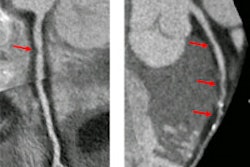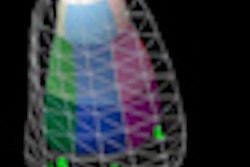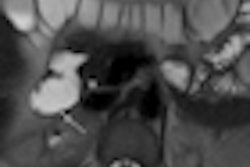With the help of 1.5-tesla cardiac MRI, German researchers have found that the human heart adapts to triathlon training by developing greater muscle mass and wall thickness, as well as larger left atria and larger right and left ventricles, according to a study to be published in the October issue of Radiology.
Findings from the multicenter study by lead researcher Michael Lell, MD, and colleagues at the University of Erlangen-Nuremberg in Erlangen are significant in that the results differ from previous research in other types of elite athletes (Radiology, August 31, 2010).
"The interesting findings point to specific and unique patterns that were observed" in triathletes, said co-investigator U. Joseph Schoepf, MD, in a telephone interview with AuntMinnie.com. "These changes have not been observed with cardiac MRI before -- so it's the first study that used MRI to really look at those things," he said.
And unlike most earlier studies, participation in triathlons doesn't rely on either resistance or endurance training "but both components, as far as long-term cardiac adaptation is concerned," said Schoepf, who is a professor of radiology and medicine at the Medical University of South Carolina in Charleston.
The researchers enrolled a total of 26 male triathletes (mean age, 27.9 years; range, 18-35) with six or more years of continuous training, as well as 27 male control subjects (mean age, 27.3 years; range, 20-34) who were recreationally active no more than three hours per week. All 53 subjects were examined with a 1.5-tesla scanner (Magnetom Espree, Siemens Healthcare, Erlangen, Germany).
The study team used a cardiac MRI protocol that involved an electrocardiographically gated steady-state free precession cine sequence to measure indexed left ventricular and right ventricular myocardial mass, end-diastolic and end-systolic volumes, stroke volume, ejection fraction, and cardiac index at rest. The ventricular remodeling index, which is indicative of the pattern of cardiac hypertrophy, was calculated.
The researchers found that the atrial and ventricular volume and mass indexes in triathletes were significantly greater than those in control subjects. In 25 of the 26 athletes, the left ventricular and right ventricular end-diastolic volumes were greater than the normal ranges reported in the literature for healthy, male, nonathletic control subjects (47-92 mL/m2 and 55-105 mL/m2, respectively).
Some of the findings, like lower blood pressure and lower resting heart rates in the athletes, were to be expected. "These are common and well-recognized effects of sports training in physiology," Schoepf said. But the significantly higher left ventricular and end-diastolic volumes in triathletes were both significant and unexpected.
There also was a strong positive correlation between end-diastolic volume and myocardial mass. The mean left ventricular and right ventricular remodeling indexes of the athletes (0.73 g/mL ± 0.1 and 0.22 g/mL ± 0.01, respectively) were similar to those of the control subjects (0.71 g/mL ± 0.1 and 0.22 g/mL ± 0.01, respectively).
"What's interesting is that the specific type of training resulted in specific changes in the myocardium," Schoepf said. "That the heart adapts in such a specific and predictable manner that is unique to a particular sport I think is noteworthy."
The triathletes' resting heart rates were 17% lower than those in the control group, which leads to increased cardiac blood supply and more economical heart function. In addition, cardiac adaptations among the elite triathletes in the study were not associated with sudden cardiac death.
The variety and prevalence of cardiac problems in athletes make these kinds of studies important, Schoepf said. One previous study examined older marathon runners using contrast-enhanced MRI and found delayed enhancement, signaling increased fibrosis in these athletes, meaning that the difference in age groups is an important factor, he said.
In fact, one of the criticisms of the present study was that it didn't use contrast and was therefore unable to evaluate whether there were any specific enhancement patterns in triathletes, for example. But the investigators felt the use of gadolinium contrast in a young, healthy population was unwarranted, Schoepf said.
Another disease process, hypertrophic cardiomyopathy, has a strong genetic component and is the No. 1 cause of death from cardiac causes in athletes. The second most common cause of death is an anomalous coronary artery. But in the younger triathlete population examined in this series, no abnormalities were found in the long-term cardiac remodeling adaptations, a fact that was interesting in itself, Schoepf said.
"That is part of the scope and thrust of this study -- to be able to differentiate normal from abnormal -- and despite the fact that we saw increases in left ventricular thickness, those never reached a level that would usually be considered pathologic, and we also saw myocardial thickening that never crossed a threshold" to a pathologic state, he said.
A better understanding of "normal" is enormously helpful for clinicians when an athlete presents with heart problems -- for example, palpitations or arrhythmia -- and the doctor makes the mistake of "attributing that to his high-performance sports participation when, in fact, the patient has hypertrophic cardiomyopathy, so defining and establishing the boundaries of normal is an important aspect of this study," he said.
As for future work, Schoepf said it would be interesting to use MRI to look at specific adaptive changes in other kinds of athletes, and to examine the differences between, for example, healthy triathletes and patients with hypertrophic cardiomyopathy.
"You assemble groups of patients with physiologic adaptations due to sports participation versus those who have disease, and basically check what's similar and what's different," he said. Examining physiologic changes in healthy versus diseased patients would be even more useful than the present study in determining the boundaries of normal, he said.
By Wayne Forrest and Eric Barnes
AuntMinnie.com staff writers
September 1, 2010
Related Reading
MRI shows age- and gender-based differences in myocardial motion, December 18, 2009
MRI detects bleeding in the heart after a heart attack, February 13, 2009
MRI evaluation of chest pain cuts acute coronary syndrome, August 15, 2008
MR studies gauge heart risk after myocardial infarction, October 15, 2007
MRI phase-mapping quantifies regional wall motion, April 3, 2006
Copyright © 2010 AuntMinnie.com



















